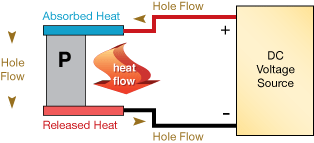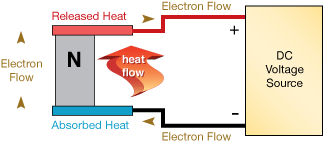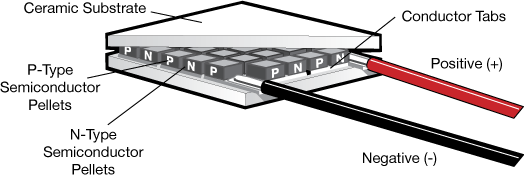Page 2 (cooling 101)
101 on cooling methodology
In nature, there are three methods of heat transfer: radiation, convection, and conduction. Without getting too methodical, radiation refers to transfer of heat in form of "waves" which can travel through any medium, including a vacuum. The heat we receive from the sun is a form heat transfer by radiation. Convection refers to transfer of heat due to the movement of substances, such as hot air rising to the top of the room. Conduction is direct transfer of energy from molecules of a hotter object to a colder one. Conduction works on the principle that the molecules of a hot object transfer their energy to the "less energetic" molecules of the colder object when they are in direct contact in order to maintain equilibrium. Air cooling of the CPU uses principles of conduction and convection to dispel excessive heat and keep the unit cool.
The heatsink must be in direct contact with the CPU core at all times, which is why thermal compounds are used to fill any possible gaps that there may be even if it is not visible by the naked eye. By means of conduction, the heat from the core is directly transferred to the heat sink. As long as the heatsink has a lower temperature than the processor core, heat will travel through them and core will be kept cool. Should the heatsink become the same temperature as the processor core then the cooling will stop being effective. So now the next problem to address is how to keep the temperature down. The main solution would be to keep the heatsink cool by transferring it's heat to the surrounding air. For maximum contact with air, increasing the surface area of the heatsink would be essential. Even so, air is a poor conductor, which means that it does not readily transfer heat. Convection comes into play here; by using a fan to force air to flow onto the heatsink, the air molecules will take away heat energy from the molecules of the heatsink when they come in contact, and carry it away as the fan pushes them out and takes in colder air from the surroundings. In this manner the temperature of the heatsink is kept down and in turn the processor remains cool. Another method is of course watercooling with water as a heat absorbent.
Heat capacity: aluminium VS. copper
In addition to surface area and the air flow through the heat sink, the material which the heatsink is made of is even more influential in cooling. For instance, different materials have different heat capacities. The heat capacity of a material indicates the amount of heat energy (measured commonly in joules or calories) a certain type of material with a certain mass can receive before it's temperature goes up by a specific amount. The heat capacity of aluminium is measured to be 900J/kg*K, which means that for a 0.25Kg block of aluminium it will take about 1125 Joules of energy to have it's temperature raised by 5 degrees. The temperature of a 0.25Kg block of copper, which is measured to have a heat capacity of 386J/Kg*K, will rise by 5 degrees with only 483 Joules of heat energy. What the heck does that mean? Simply it means that copper will rise in temperature more than aluminium when the same amount of heat is applied. Does this mean that aluminium is a better cooling material than copper? Not necessarily, because there is a more important factor to consider: thermal conductivity.
Thermal conductivity: aluminium VS. copper
Thermal conductivity, as it obviously implies, is a measure of how well a type of material can conduct heat. A higher thermal conductivity means a better conductor of heat. Copper has almost twice the thermal conductivity of aluminium (401 W/m*k compared to 237 W/m*k), which makes it a clear choice over aluminium for CPU cooling as it can transfer high amounts of heat more efficiently. The main reason for comparing aluminium and copper is because most older HSF products use aluminium for the heatsink, while recently the trend in cooling products is to use copper instead.
Now when we take this a step further we can see a couple of main methods for cooling down a processor.
Air-cooling
There are two problems with fans as I see it. The first is that your system never gets cooler than the temperature in the case/room. The other thing is that too many or wrong fans can be really noisy. Primarily there is the size and the speed of the fan that determines if its going to be noisy or not. The bigger the fan, the higher the noise level and higher rotations per minute means a higher level of noise. Another consideration is how much air the fan sucks or blows. This is measured in CFM, the higher the better. Please note that it will probably be noisier as the CFM rises. The good side to air cooling is that it is safer to use than peltier or water-cooling solutions.
Phase Change Cooling
While almost everyone has experienced the effect of phase change cooling (your refrigerator), what many might not know is how the process actually works. In essence, there are four key mechanisms on the go in a phase change system. These parts are connected in a closed loop by tubing, this loop is filled with refrigerant which acts as a transport medium for the heat. Hence the name phase change as this coolant is when it is absorbing a huge amount of heat is changing from a liquid to a gas.
So the coolant is the moving around heat. The refrigerant material is unusual in that it has a very low boiling (or vaporizing) point well below 0°C at atmospheric pressure and a freezing point more than 100°C below zero. It is liquid when cold but easily becomes a vapor when heated and vice versa. This method however is extremely noisy and extremely expensive.
We recently reviewed this technology. Have a look here.
Water-cooling
Overall water-cooling is silent as you can take out a couple of fans from your PC. It however is a bit of a paradox though as once we are doing that you need to realize the radiator usually needs one or two big 120mm fan if you are cooling actively. Passively is more impressive though, as no sound is involved and we pretty much let nature take it's course.
A second reason for choosing water-cooling is the it's high efficiency method of cooling. With a very simple solution you can cool down a lot, high-end processors running under 35-40 Degrees C is what this really is about. And that has a second benefit. Better cooled products can be overclocked a little higher. One of the most common and fundamental methods of increasing system performance lies in the CPU performance. Since the speed at which processes can be carried out depends on the clock cycle of the CPU, by overclocking (increasing the clock frequency) considerable speed can be gained. Recently overclocking has become more popular mainly because of the value line-up of AMD and Intel products that can be overclocked quite easily and have quite a bit of potential. However, since the users are stepping over the manufacturer's recommended settings, excessive heat is one the major obstacles to overcome. If this little fact is not respected, the extra generated heat can cause major system instabilities, shorter processor life and, in some extreme cases, completely burn out the processor. I have never had that happen but in a weird way that would be kind of cool to observe wouldn't it ?
Peltier-cooling
If you want extreme cooling, a peltier can be what youre looking for. Basically it is a very small element that gets very cool, it can actually go WAY below zero which is dangerous with condensation in mind. And then there's this ... on the other hand, it gets really hot on the other side of the element and youll have to take away that heat with air-cooling or better. My biggest boggle was not the CPU getting too hot but the graphics card and the chipset on the motherboard. Heat stays in the case unless a fan-duct will remove the heat.
We know Peltier cooling under several names, TEC .. Peltier, thermo-electric cooling and di-electric cooling. It's all the same.


The Peltier effect occurs whenever electrical current flows through two dissimilar conductors; depending on the direction of current flow, the junction of the two conductors will either absorb or release heat. Explaining the Peltier effect and its operation in thermoelectric devices, is a very challenging proposition because it ultimately keys on some very complex physics. In the world of thermoelectric technology, semiconductors are the material of choice for producing the Peltier effectin part because they can be more easily optimized for pumping heat, but also because designers can control the type of charge carrier employed within the conductor. Using this type of material, a Peltier device (i.e., thermoelectric module) can be constructed in its simplest form around a single semiconductor 'pellet' which is soldered to electrically-conductive material on each end (usually plated copper). In this 'stripped-down' configuration, the second disimilar material required for the Peltier effect, is actually the copper connection paths to the power supply.

